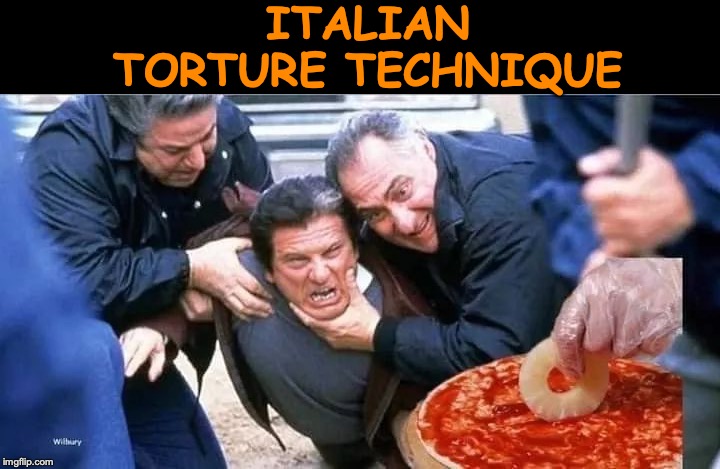
Ping

If my grandmother had wheels, she would have been a bicycle
Infamia!
This story makes me think there's still some hope for them.
The Lionfield paisans on YouTube will be invading the UK.
Who in the world is against butter?
Oh well. None of my never mind.
Heinz has already done it to the Brits.

Wait - ketchup over Ramen noodles isn’t spaghetti? My whole college career was a sham...
Question 1) “Russia is invading your homeland. Will you join up and fight?”
Answer 1) “No.”
Question 2) “Foreigners have added an inappropriate ingredient to one of our recipes. Will you —”
Answer 2) “Say no more. I’m heading to the recruitment center.”
Not that long ago Europeans were planning to add crickets to their pasta flour...
I remember a tour guide almost gagging when she mentioned "all the things Americans put on pizza."
I tend to be philosophical about cultural peculiarities, but even I was a bit red-faced when my grandchildren asked for pizza at La Fenice in Venice.
The guineas are right in this instance. The gastronomically challenged poofyer limeys with their cooking which is pony are wrong. Not an opinion. Fact!
Italian chef Giorgio got his fingers caught in a food processor.
He suffered a speech impediment for the rest of his life.
If it’s pineapple they’re right to protest.
LOL!! It sounds like the Ambassador has a nice sense of the redonkuluss.
Cacio e Pepe (pronounced ca-cho ee pepe) is a classic Roman pasta dish, whose name translates to “cheese and pepper”. This simple, yet incredibly flavorful dish, is a staple of Roman cuisine and has gained global popularity for its creamy texture and rich taste.
Traditionally made with long pasta shapes like tonnarelli, bucatini, or spaghetti. Pecorino Romano, an aged sheep’s cheese, is the star ingredient. It provides the dish with its signature salty and tangy flavor, and is crucial for creating the creamy sauce. Freshly ground black pepper is essential. Toasting the pepper before adding it to the dish enhances its aromatic qualities and flavor profile.
The starchy water left over from cooking the pasta is key to creating a smooth, emulsified sauce.
While simple in terms of ingredients, mastering Cacio e Pepe requires some attention to detail to achieve the desired creamy, smooth sauce: Grate the cheese: Finely grate Pecorino Romano cheese. Cook the pasta: Boil the pasta in lightly salted water, cooking it until it is just under al dente. Reserve some of the starchy cooking water before draining. Toast the pepper: Toast freshly cracked black pepper in a dry pan until fragrant.
Create the sauce base: Add some of the reserved pasta water to the pan with the toasted pepper and simmer. Emulsify the cheese: Turn off the heat and gradually add the grated cheese, tossing vigorously to melt it and create a creamy sauce, adding more pasta water as needed to adjust consistency. Combine and serve: Add the cooked pasta to the pan and toss everything together, ensuring the pasta is well coated in the sauce. Serve immediately, topped with extra Pecorino Romano and freshly ground black pepper.
Tips for success Use high-quality ingredients, especially the Pecorino Romano cheese. Grate the cheese fresh for the best texture and melting consistency. Don’t be afraid to add extra pasta water if the sauce appears too thick or lumpy. Tossing the pasta and sauce vigorously helps in creating a smooth emulsion.
Cacio e Pepe is a testament to the power of simple, high-quality ingredients and careful technique in creating a truly delicious dish.
Shut up about Mandami. Who cares about Texas’ voting districts. Here is an issue concerning to all of us!
This article is not from Babylon Bee!